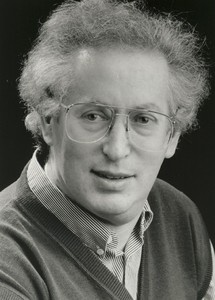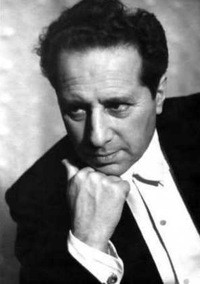
Samuil Abramovich Samosud (Samuil Samosud) |
Samuil Samosud

Soviet conductor, People’s Artist of the USSR (1937), winner of three Stalin Prizes (1941, 1947, 1952). “I was born in the city of Tiflis. My father was a conductor. Musical inclinations manifested themselves in my early childhood. My father taught me to play the cornet-a-piston and the cello. My solo performances began at the age of six. Later, at the Tiflis Conservatory, I began to study wind instruments with Professor E. Gijini and cello with Professor A. Polivko.” So Samosud begins his autobiographical note.
After graduating from the music school in 1905, the young musician went to Prague, where he studied with the famous cellist G. Vigan, as well as with the chief conductor of the Prague Opera K. Kovarzovits. Further improvement of S. A. Samosud took place in the Parisian “Schola Cantorum” under the direction of the composer V. d’Andy and conductor E. Colonne. Probably, even then he made the decision to devote himself to conducting. Nevertheless, for some time after returning from abroad, he worked as a soloist-cellist in the St. Petersburg People’s House.
Since 1910, Samosud has acted as an opera conductor. In the People’s House, under his control, there are Faust, Lakme, Oprichnik, Dubrovsky. And in 1916 he conducted the “Mermaid” with the participation of F. Chaliapin. Samosud recalled: “Galinkin, who usually performed Shalyapin’s performances, was unwell, and the orchestra strongly recommended me. In view of my youth, Chaliapin was distrustful of this proposal, but nevertheless agreed. This performance played a huge role in my life, since in the future I conducted almost all of Chaliapin’s performances, and already at his insistence. Everyday communication with Chaliapin – a brilliant singer, actor and director – was for me a huge creative school that opened up new horizons in art.
Samosud’s independent creative biography is, as it were, divided into two parts – Leningrad and Moscow. After working at the Mariinsky Theater (1917-1919), the conductor headed the musical group born in October – the Maly Opera Theater in Leningrad and was its artistic director until 1936. It is thanks to the merits of Samosud that this theater has rightfully earned the reputation of a “laboratory of Soviet opera.” Excellent productions of classical operas (The Abduction from the Seraglio, Carmen, Falstaff, The Snow Maiden, The Golden Cockerel, etc.) and new works by foreign authors (Krenek, Dressel, etc.) ). However, Samosud saw his main task in creating a modern Soviet repertoire. And he strived to fulfill this task persistently and purposefully. Back in the twenties, Malegot turned to performances on revolutionary themes – “For Red Petrograd” by A. Gladkovsky and E. Prussak (1925), “Twenty-Fifth” by S. Strassenburg based on Mayakovsky’s poem “Good” (1927), A group of young people concentrated around Samosud Leningrad composers who worked in the opera genre – D. Shostakovich (“The Nose”, “Lady Macbeth of the Mtsensk District”), I. Dzerzhinsky (“Quiet Flows the Don”), V. Zhelobinsky (“Kamarinsky Muzhik”, “Name Day”), V Voloshinov and others.
Lynching worked with rare enthusiasm and dedication. Composer I. Dzerzhinsky wrote: “He knows the theater like no one else … For him, an opera performance is a fusion of a musical and dramatic image into a single whole, the creation of a truly artistic ensemble in the presence of a single plan, the subordination of all elements of the performance to the main, leading idea of uXNUMXbuXNUMXbthe work … Authority C A. Self-judgment is based on great culture, creative courage, the ability to work and the ability to make others work. He himself delves into all the artistic “little things” of the production. He can be seen talking with artists, props, stage workers. During a rehearsal, he often leaves the conductor’s stand and, together with the director, works on mise en scenes, prompts the singer for a characteristic gesture, advises the artist to change this or that detail, explains to the choir an obscure place in the score, etc. Samosud is the real director of the performance, creating it according to carefully thought out – in great detail – plan. This gives confidence and clarity to his actions.”
The spirit of search and innovation distinguishes the activities of Samosud and in the post of chief conductor of the Bolshoi Theater of the USSR (1936-1943). He created here truly classic productions of Ivan Susanin in a new literary edition and Ruslan and Lyudmila. Still in the orbit of the conductor’s attention is the Soviet opera. Under his direction, I. Dzerzhinsky’s “Virgin Soil Upturned” is staged at the Bolshoi Theater, and during the Great Patriotic War he staged D. Kabalevsky’s opera “On Fire”.
The next stage of Samosud’s creative life is associated with the Musical Theater named after K. S. Stanislavsky and V. I. Nemirovich-Danchenko, where he was the head of the musical department and chief conductor (1943-1950). “It is impossible to forget the rehearsals of Samosud,” write the theater artists N. Kemarskaya, T. Yanko and S. Tsenin. — Whether the merry operetta “The Beggar Student” by Millöker, or the work of great dramatic breath — “Spring Love” by Encke, or Khrennikov’s folk comic opera “Frol Skobeev” — were being prepared under his leadership — how penetratingly Samuil Abramovich was able to look into the very essence of the image, how wisely and subtly he led the performer through all the trials, through all the joys inherent in the role! As Samuil Abramovich artistically revealed at the rehearsal, the image of Panova in Lyubov Yarovaya, which is very complex both in musical and acting terms, or the impetuous and quivering image of Laura in The Beggar Student! And along with this – the images of Euphrosyne, Taras or Nazar in the opera “The Family of Taras” by Kabalevsky.
During the Great Patriotic War, Samosud was the first performer of D. Shostakovich’s Seventh Symphony (1942). And in 1946, Leningrad music lovers saw him again at the control panel of the Maly Opera Theatre. Under his direction, the premiere of S. Prokofiev’s opera “War and Peace” was held. Samosud had a particularly close friendship with Prokofiev. He was entrusted by the composer to present to the audience (except for “War and Peace”) the Seventh Symphony (1952), the oratorio “Guarding the World” (1950), the “Winter Fire” suite (1E50) and other works. In one of the telegrams to the conductor, S. Prokofiev wrote: “I remember you with warm gratitude as a brilliant, talented and impeccable interpreter of many of my works.”
Heading the theater named after K.S. Stanislavsky and V.I. Nemirovich-Danchenko, Samosud simultaneously led the All-Union Radio Opera and Symphony Orchestra, and in recent years he has been at the head of the Moscow Philharmonic Orchestra. In the memory of many, his magnificent performances of operas in concert performance have been preserved – Wagner’s Lohengrin and Meistersingers, Rossini’s The Thieving Magpies and The Italians in Algeria, Tchaikovsky’s Enchantresses … And everything done by Samosuda for the development of Soviet art will not be forgotten neither musicians nor music lovers.
L. Grigoriev, J. Platek





